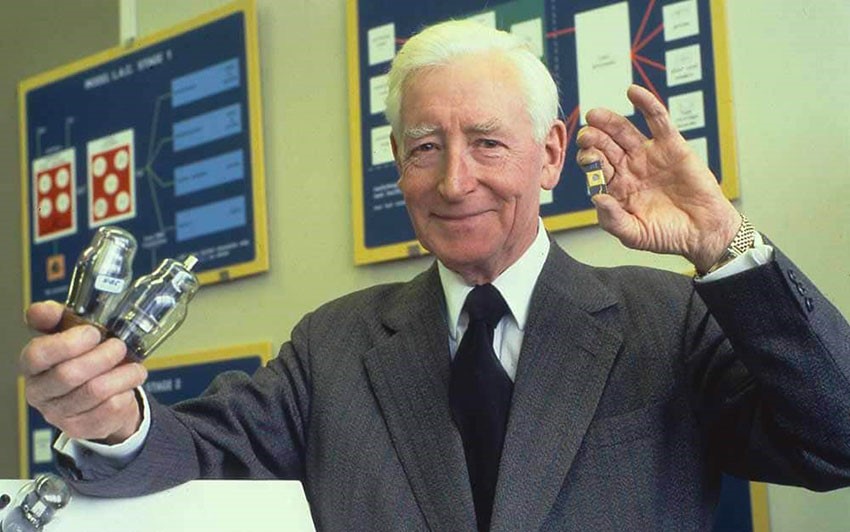The engineer who discovered the possibility of using electronics for telephone calls: Who is Thomas Harold Flowers?
Designer of Colossus, the world's first programmable digital electronic computer, used to decipher German codes in World War II.

British engineer Thomas Harold Flowers was born in London on December 22, 1905, to a construction master father. After his Mechanical Engineering internship at the Royal Arsenal, he took evening courses in Electrical Engineering at the University of London.
In 1926 he joined the Telecommunications Department of the British Post Office and in 1930 he moved to south-west London to work at the research station at Dollis Hill. Flowers married Eileen Margaret Green in 1935 and had two children, John and Kenneth.
After 1935, Flowers explored the possibility of using electronics for telephone conversations. By 1939, he was sure that a completely electronic system was possible, and this discovery would form the background of his computer design in World War II.
Thomas Harold Flowers (22 December 1905 - 28 October 1998) was an English engineer with the British General Post Office. During World War II, Flowers designed and built Colossus, the world's first programmable electronic computer, to help decipher encrypted German messages.
Flowers' first connection with wartime ciphering came from an offer he received from Alan Turing, who worked for the government's cipher organization in Bletchley Park. Turing asked Flowers to design a decoder for the electromechanical Bombe machine, which he developed to decipher the German Enigma.
Although the decoder project was later abandoned, Turing was very impressed by Flowers' work. Therefore, he introduced him to Max Newman, the head of the team trying to solve the Germans' Secret Printer (Geheimschreiber). Geheimschreiber was a much more complex cipher system than Enigma. In February 1943, Flowers proposed an electronic system carrying over 1,800 valves: Colossus.
The previous most complex electronic device had about 150 valves, and there were doubts about its reliability. Flowers disputed the use of thousands of valves in the British telephone system and the reliability of the system. According to Flowers, electronics always operate in a stable environment covered with circuits. Bletchley Park management was less than convinced, but they encouraged Flowers to develop the project on his own. So he did; In fact, he provided most of the necessary funds. He subsequently became a member of the British Imperial Team on 2 June 1943.
Dollis Hill manager W G Radley gave Flowers his full support on this project. Flowers' eager team at Dollis Hill finished the first machine in eleven months. Due to its large size, the machine was directly registered as Colossus by the Bletchley Park team. It worked five times faster and more easily than its predecessor, Heath Robinson. Anticipating that additional computers would be needed, a Mark 2 version containing 2400 valves was started before the first computer was completed.
The first Mark 2 Colossus was brought into service at Bletchley Park on 1 June 1944 and began to acquire important data for the rapid D-Day landings planned for 6 June. Flowers had a very important meeting with Dwight D. Eisenhower and his team on June 5. A decryption had come from Colossus. Accordingly, Hitler did not want additional forces for the Normandy landing and was still very confident that this landing would be a fun feint. Reading the password, Eisenhower called out to his team: "We're leaving tomorrow!"
Years later, Flowers explained the design and structure of these computers. Ten Colossus were produced and used in Britain during World War II. Towards the end of the war, he was ready for the eleventh mission. By the end of the war, all but two had been dismantled and the remaining two Colossuses were taken to the British News Section (GCHQ) in Cheltenham. Here they could be used in Cold War operations, but they were completely removed from use in 1959 and 1960.
Following the war, Flowers was given a salary of £1,000 by the government. This fee did not cover his personal equipment expenses. Flowers's work on computers was not fully known until the 1970s; because the project was kept secret by the government. His family was only aware that he was doing "secret and important" work. During the peace years, Thomas Flowers returned to his post at the British Post Office and became head of the switching department. He and his group worked to develop electronic telephones and came up with a simple design in the 1950s. In 1964, he became head of the advanced development group at Standard Telephones and Cables. He worked here until his retirement in 1969.
Thomas Harold Flowers passed away on October 28, 1998, leaving behind his wife and two children. His name is commemorated in the former Post Office Research Station, which has now been converted into a development house. The main building of this station also faces a road paved with flags: Flowers Close.
